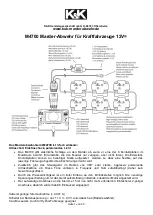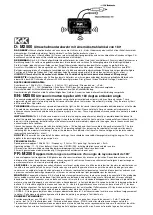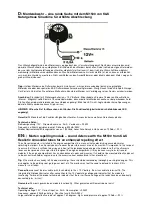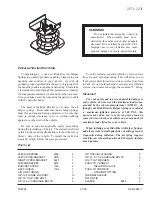
Emergencies
CAUTION
●
When tow-starting, unburnt fuel could
enter the catalytic converter and damage
it.
●
Do not tow a vehicle for more than 50 m
in attempt to start it. There is risk of dam-
age to the catalytic converter.
Note
The vehicle can only be tow-started if the
electronic parking brake and, if appropri-
ate, the electronic lock of the steering col-
umn are deactivated. If the vehicle has no
power supply or there is an electric system
fault, the engine must be tow-started to de-
activate the electronic parking brake and
the electronic lock of the steering column.
Towing instructions
Towing requires some expertise and experi-
ence, especially when using a tow rope. Both
drivers should be familiar with the difficulties
involved in towing. For this reason, inexper-
ienced drivers should abstain from towing.
During towing, it should be ensured that no
impermissible tractive forces or shocks are
generated. When towing on an unpaved
road, there is always a risk of overloading and
damaging the anchorage points.
During towing, the towing vehicle can signal
the change of direction even with the hazard
warning lights turned on. To do so, at the
same time, the turn signal lever must be oper-
ated with ignition switched on. Meanwhile, the
hazard warning lights will go off. When the
turn signal lever is returned to the rest posi-
tion, the hazard warning lights will be auto-
matically reactivated.
Notes for the driver of the towed vehicle
●
Leave the ignition on, so that the steering is
not blocked, and the electronic parking brake
may be deactivated and the turn signals and
wash/wipe operated.
●
More strength is required at the steering
wheel as the power steering does not oper-
ate when the engine is switched off.
●
You should depress the brake much harder
as the brake servo does not operate. Avoid
hitting the towing vehicle.
●
Bear in mind the information and instruc-
tions in the manual of the vehicle to be towed.
Notes for the driver of the towing vehicle
●
Accelerate with particular care and cau-
tion. Avoid sharp manoeuvres.
●
Brake earlier than usual and smoothly.
●
Bear in mind the information and instruc-
tions in the manual of the towed vehicle.
Tow rope or tow bar
It is safer for the vehicle to be towed using a
tow bar, avoiding damage to the vehicle. A
tow rope should only be used if a tow bar is
not available.
A tow rope should be slightly elastic to avoid
damage to both vehicles. It is advisable to
use a tow rope made of synthetic fibre or sim-
ilarly elastic material.
Only attach the tow rope or the tow bar to
the towing eyes provided or a towing bracket.
If the vehicle has a
factory-fitted towing de-
vice,
towing with a tow bar is
only
permitted
if it has been specially designed to be instal-
led on a tow hitch
.
When the vehicle has to be towed:
Check whether the vehicle may be towed
›››
page 55, Cases where towing the ve-
.
The vehicle can be towed using a tow bar or
tow rope in the normal way, with all four
wheels on the road; it can also be towed with
either the front or rear wheels lifted off the
road.
●
Switch the ignition on.
●
Put the gearbox lever in neutral or the se-
lector lever in the
N
position.
●
Do not allow the vehicle to be towed at
speeds of over 50 km/h (30 mph).
54
Summary of Contents for Tarraco 2020
Page 64: ...Operation Fig 56 Instruments and controls 62 ...
Page 170: ...Infotainment System Main menus Fig 161 Menu summary 168 ...
Page 394: ...Technical data Dimensions Fig 325 Dimensions 392 ...
Page 396: ......
Page 412: ......
Page 413: ......
Page 414: ......
Page 416: ...Owner s manual SEAT Tarraco 5FJ012720BD Inglés 5FJ012720BD 11 19 SEAT Tarraco Inglés 11 19 ...
Page 417: ...Appendix to Owner s manual SEAT Tarraco FR ...
Page 418: ......
















































